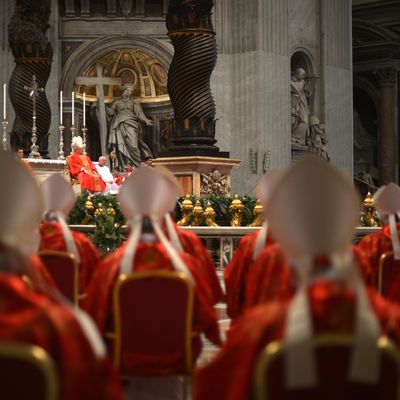
The esoteric “Election of the Supreme Pontiff” begins today in the Vatican as the princes of the Catholic Church convene to select a new leader. The all-male gathering is one of intrigue and tradition, leaving the rest of the world to once again attempt to understand the seemingly arbitrary rules. At the end, there will be a new pope, but first: pasta, smoke, and a few important numbers, which we’ve laid out below.
115: The number of cardinal electors that will take the oath of secrecy and lock themselves in the Sistine Chapel to hash things out. They’re scheduled to begin today at 11:30 a.m. EST.
80: The conclave’s age limit. Only cardinals under the age of 80 can participate in the voting festivities. That’s important this time around because Cardinal Ratzinger, who became Pope Benedict XVI in 2005, is thought to have won himself some crucial support by delivering the pre-conclave welcome speech. This morning, the top billing was reserved for Cardinal Angelo Sodano, dean of the College of Cardinals, who is too old to be included.
Three: Major factions within the conclave. According to the New York Times, “The cardinals have appeared divided over whether the next pope should be an outsider who would reform the Italian-dominated Curia, or Vatican bureaucracy; an internal choice who could bring change from within; or a galvanizing leader who can shore up the Catholic Church in the face of growing secularism and inroads by Protestant evangelicals.”
Two: Favorites. CBS reports that “oddly, an Italian — Cardinal Angelo Scola — is the champion of the reformist camp supported by many non-Italian cardinals, those who seem to want to reform the way the Church runs itself. Conversely, a Brazilian — Odilo Scherer — is a traditionalist and supported by the largely-Italian faction which would prefer to leave the Curia to go about its business more or less as usual.”
1.2 billion: The estimated number of Catholics worldwide.
52 percent: The percentage of cardinal electors hailing from Europe, despite the continent making up only 24 percent of the world’s Catholics. Sub-Saharan Africa, on the other hand, has 16 percent of the world’s Catholics, but only 9 percent of the conclave, according to this helpful graphic from Pew.
61 percent: The percentage of Africans who said the world is ready for an African pope, according to a CNN survey.
Four: Voting rounds per day. The cardinals have the option of voting once on the first day of the conclave, but it’s unlikely that anyone will have the support needed at that point. In subsequent days, they will vote twice in the morning and twice in the evening. According to NPR, “while the cardinals won’t be talking among each other and looking to build alliances while in the Sistine Chapel, they will almost surely ‘be busy murmuring in each others’ ears over coffee and pasta’ when they take breaks.”
77: Votes needed to win. A cardinal needs to surpass the two-thirds majority to become pope. Votes are written onto rectangular paper and placed in a “flying-saucer shaped urn.”
One: Color of smoke that matters. After each tally, the votes are burned in a special oven. Chemicals are added to make the smoke black, which means there is no pope, or white, which means it’s all over, although “just how those colors are created remains a bit of a mystery.” The victor will then emerge on the balcony and deliver a blessing onto St. Peter’s Square.





























